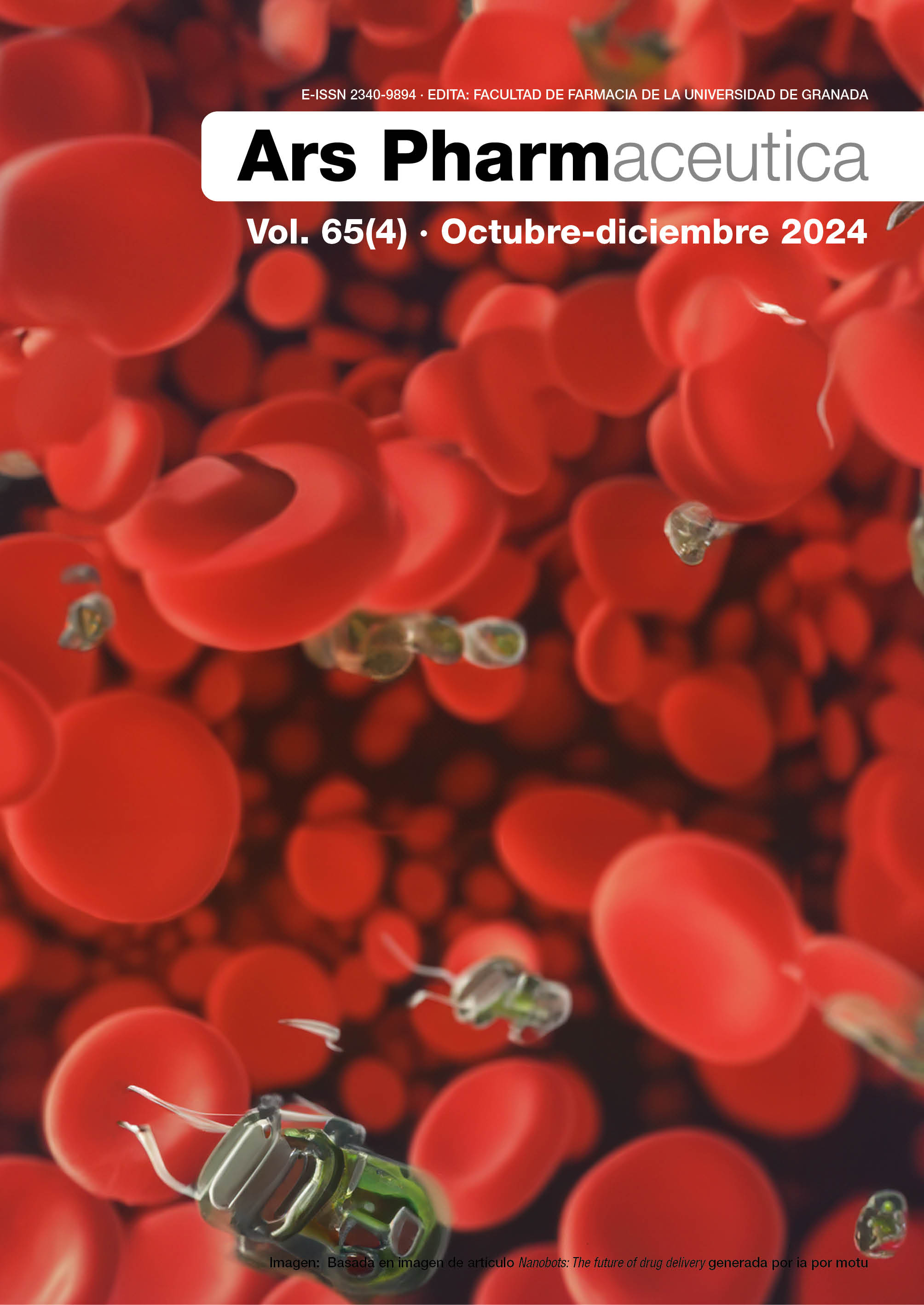Safety profile of Paxlovid® against SARS-CoV2 in patients at a hospital in Mexico
DOI:
https://doi.org/10.30827/ars.v65i4.30863Keywords:
safety, Paxlovid®, COVID-19, nirmatrelvir, ritonavir, Antiviral Agents, OutpatientsAbstract
Introduction: Due to the increase in infections of the Omicron variant of Coronavirus Disease 2019, the Mexican health authority authorized the oral antiviral Paxlovid® for the outpatient treatment of patients with mild to moderate infection. Having a limited safety profile, the objective was to describe the adverse reactions and other safety problems related to the use, treated in a tertiary hospital in Mexico and compare them with those reported in other countries.
Method: Semilongitudinal and prospective clinical series developed out at the Regional High Specialty Hospital of the Yucatan Peninsula between October 17, 2022, and July 10, 2023. Patients treated with Paxlovid® were interviewed by telephone calls and were asked about any adverse reactions presented.
Results: A total of 65 patients were included. The average age was 46,8±15,3 years. 89,2 % (n=58) presented one or more adverse reactions and 13,8 % (n=9) discontinued treatment due to them. In general, 132 adverse reactions were identified, 2±1 per patient, the most frequent being mild (78 %) such as bitter taste, nausea and fatigue. Other adverse reactions not reported in the Paxlovid® package insert was identified.
Conclusions: Paxlovid® has an acceptable safety profile comparable to that of other studies, this being consistent with previous clinical experience and supporting the safety of the use of nirmatrelvir y ritonavir combination drug as a therapeutic option against Coronavirus Disease 2019.
Downloads
References
Saravolatz LD, Depcinski S, Sharma M. Molnupiravir and Nirmatrelvir-Ritonavir: Oral COVID Antiviral Drugs. Clin Infect Dis. 2022;76(1). DOI: 10.1093/cid/ciac180. DOI: https://doi.org/10.1093/cid/ciac180
Marzolini C, Kuritzkes DR, Marra F, Boyle A, Gibbons S, Flexner C, et al. Recommendations for the management of drug-drug interactions between the COVID-19 antiviral nirmatrelvir/ritonavir (Paxlovid ®) and comedications. Clin Pharmacol Ther. 2022; 112(6). DOI:10.1002/cpt.2646. DOI: https://doi.org/10.1002/cpt.2646
Reis S, Maria-Inti Metzendorf, Kuehn R, Popp M, Ildikó Gágyor, Kranke P, et al. Nirmatrelvir combined with ritonavir for preventing and treating COVID-19. Cochrane Libr. 2023;2023(11). DOI: 10.1002/14651858.CD015395.pub2. DOI: https://doi.org/10.1002/14651858.CD015395.pub3
Lineamiento operativo en el uso de emergencia de Combinación de nirmatrelvir y ritonavir (Nirmatrelvir / ritonavir) en grupos de riesgo para COVID-19, en México [Internet]. Gob.mx. [citado el 18 de septiembre de 2023]. Disponible en: https://coronavirus.gob.mx/wp-content/uploads/2023/01/Lineamientos-act_Pax_160123_vf.pdf
Paho.org. [citado el 15 de diciembre de 2023]. Disponible en: https://www3.paho.org/hq/index.php?option=com_docman&view=download&alias=33513-buenas-pra-cticas-farmacovigilancia-ame-ricas-2010-513&category_slug=documentos-8499&Itemid=270&lang=es
Reina J, Iglesias C. Nirmatrelvir más ritonavir (Paxlovid) una potente combinación inhibidora de la proteasa 3CLpro del SARS-CoV-2 [Nirmatrelvir plus ritonavir (Paxlovid) a potent SARS-CoV-2 3CLpro protease inhibitor combination]. Rev Esp Quimioter. 2022;35(3):236-240. DOI: 10.37201/req/002.2022. DOI: https://doi.org/10.37201/req/002.2022
Blair HA. Nirmatrelvir plus ritonavir in COVID-19: a profile of its use. Drugs Ther Perspect. 2022;39(2):41–7. DOI: 10.1007/s40267-022-00971-1. DOI: https://doi.org/10.1007/s40267-022-00971-1
Cvancara DJ, Baertsch HC, Lehmann AE, Humphreys IM, Nyssa Fox Farrell, Marshall TB, et al. Postmarketing Reporting of Paxlovid-Related Dysgeusia: A Real-World Pharmacovigilance Study. JAMA Otolaryngol Head Neck Surg. 2023: 169(1): 55-61. DOI: 10.1002/ohn.278. DOI: https://doi.org/10.1002/ohn.278
Pfizer Inc. Combinación de nirmatrelvir y ritonavir (nirmatrelvir and ritonavir) tablets: Highlights of prescribing information [Internet]. New York: Pfizer Inc.; [citado el 16 junio 2024]. Disponible en: https://labeling.pfizer.com/ShowLabeling.aspx?id=20001
Hammond J, Leister-Tebbe H, Gardner A, Abreu P, Bao W, Wisemandle W, et al. Oral Nirmatrelvir for High-Risk, Nonhospitalized Adults with Covid-19. N Engl J Med. 2022;386(15). DOI: 10.1056/NEJMoa2118542. DOI: https://doi.org/10.1056/NEJMoa2118542
Wen W, Chen C, Tang J, Wang C, Zhou M, Cheng Y, et al. Efficacy and safety of three new oral antiviral treatment (molnupiravir, fluvoxamine and Paxlovid) for COVID-19: a meta-analysis. Ann Med. 2022;54(1):516–23. DOI: 10.1080/07853890.2022.2034936. DOI: https://doi.org/10.1080/07853890.2022.2034936
Tian H, Yang C, Song T, Zhou K, Wen L, Tian Y, et al. Efficacy and safety of paxlovid (nirmatrelvir/ritonavir) in the treatment of COVID-19: An updated meta-analysis and trial sequential analysis. Rev Med Virol. 2023;33(5). DOI: 10.1002/rmv.2473. DOI: https://doi.org/10.1002/rmv.2473
Liu J, Pan X, Zhang S, Li M, Ma K, Fan C, et al. Efficacy and safety of Paxlovid in severe adult patients with SARS-Cov-2 infection: a multicenter randomized controlled study. Lancet Reg Health West Pac [Internet]. 2023;0(0). DOI: 10.1016/j.lanwpc.2023.100694. DOI: https://doi.org/10.1016/j.lanwpc.2023.100694
Paxlovid side effects [Internet]. Drugs.com. [citado el 15 de diciembre de 2023]. Disponible en: https://www.drugs.com/sfx/paxlovid-side-effects.html
Brooks JK, Song JH, Sultan AS. Paxlovid-associated dysgeusia. Oral Dis. 2023;29(7):2980-2981. DOI: 10.1111/odi.14312. DOI: https://doi.org/10.1111/odi.14312
Ram S, Wada T, Sahai-Srivastava S. Neurosensory disturbances including smell and taste. In: Farah CS, Balasubramaniam R, McCullough MJ, editors. Contemporary oral medicine. 1st ed. Cham: Springer; 2020. p. 11-16. DOI: https://doi.org/10.1007/978-3-319-28100-1_26-1
Amani B, Amani B. Efficacy and safety of nirmatrelvir/ritonavir (Paxlovid) for COVID-19: A rapid review and meta-analysis. J Med Virol. 2023;95(2). DOI: 10.1002/jmv.28441. DOI: https://doi.org/10.1002/jmv.28441
Downloads
Published
How to Cite
Issue
Section
License
Copyright (c) 2024 Belem Chan Canche

This work is licensed under a Creative Commons Attribution-NonCommercial-ShareAlike 4.0 International License.
The articles, which are published in this journal, are subject to the following terms in relation to the rights of patrimonial or exploitation:
- The authors will keep their copyright and guarantee to the journal the right of first publication of their work, which will be distributed with a Creative Commons BY-NC-SA 4.0 license that allows third parties to reuse the work whenever its author, quote the original source and do not make commercial use of it.
b. The authors may adopt other non-exclusive licensing agreements for the distribution of the published version of the work (e.g., deposit it in an institutional telematic file or publish it in a monographic volume) provided that the original source of its publication is indicated.
c. Authors are allowed and advised to disseminate their work through the Internet (e.g. in institutional repositories or on their website) before and during the submission process, which can produce interesting exchanges and increase citations of the published work. (See The effect of open access).























